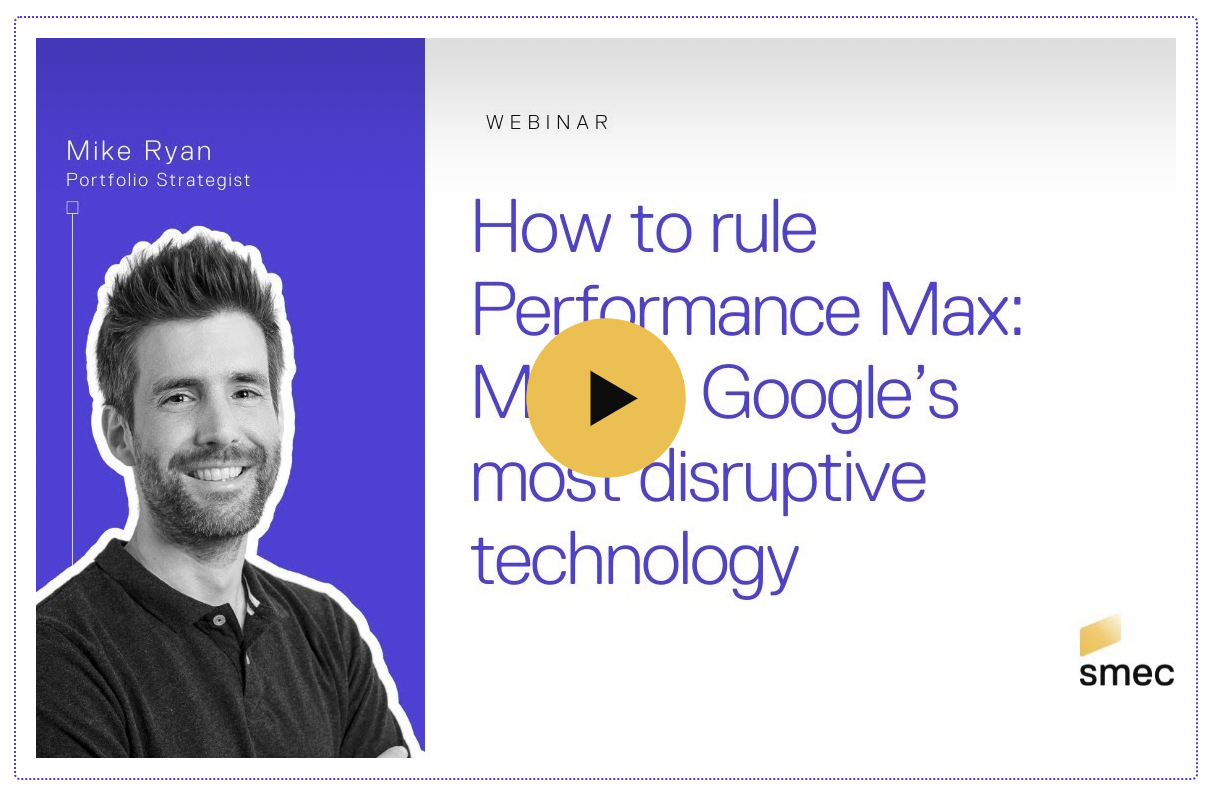Subscribe to join thousands of other ecommerce experts

Performance Max (PMax) campaigns are the latest and most extensive example yet of automation in Google’s advertising platform. Hence, many online retailers are now looking for Performance Max best practices. In this article, I will show you which components you need for a successful Performance Max campaign in ecommerce and what options you have moving forward.
Update: As we navigate 2025, Performance Max campaigns continue to evolve, demanding sharper strategies to unlock their full potential. If you’re looking for the cutting-edge in PMax optimization, check out our newest resource: “PMax in 2025: The ultimate campaign optimization guide“. This blog goes beyond basic setups, diving into advanced techniques like multi-dimensional segmentation and predictive scoring to align campaigns with business goals. Whether you’re aiming for profit growth or enhanced campaign control, this guide offers actionable insights tailored for ecommerce success.
Table of Contents
What is Performance Max, really?
Let’s quickly describe what PMax campaigns are – not in the generic “these are asset groups, these are listing groups” sense. Let’s discuss what the technology really is and why that matters.
Performance Max according to Google
While Google has automated auctions with Smart Bidding for years and then launched a more-or-less “plug and play” ecommerce campaign type with Smart Shopping campaigns, Performance Max for Retail eclipses the ambition of both – by far.
The best definition of Performance Max is probably the one by Google’s API documentation: “a unified buying service to all Google Ads inventory”. That means a complete de-channeling of Google Ads for both retail and non-retail businesses. Which, in turn, means that Google is automating bids, budget allocation, placements, and creatives.
Why Performance Max campaigns are special
Performance Max is a strange, speckled beast. It is reminiscent of Smart Shopping, Responsive Display, and Dynamic Search all at once. In fact, Google has confirmed that Smart Shopping campaigns and Local campaigns will get an “upgrade” to Performance Max later this year. And I don’t see any reason why Dynamic Search Ad campaigns (and perhaps others) shouldn’t follow. However, I wouldn’t say those campaigns are being upgraded: I’d say they’re being swallowed and incorporated.
My point is that Performance Max is a new advertising platform incubating within the old one. Standard campaigns will remain for the next few years, but Performance Max will be the launching pad for every new capability and format. For retail campaigns, Performance Max will go hand-in-hand with new developments to the Merchant Center, which in turn will hold more gravity as a gateway to Google’s Shopping Graph.
Standard campaigns might never be removed, but they will shrink into something vestigial – like a tailbone or an appendix.
Performance Max is a unified buying service to all Google Ads inventory, automating bids, budget allocation, placements, and creatives.
I also talk about this in the following video:
However, for more detailed Performance Max insights and strategies, I recommend you read on.
What are the implications of Performance Max for online retailers?
Performance Max covers more channels and formats, offers more complexity, and supports far more assets in order to dynamically build many kinds of ads. Yet there is a tradeoff of such extensive automation. Performance Max is also a very closed system when you compare it to standard campaign types. More than any other Google advertising technology, Performance Max for ecommerce calls for a modernised approach to management that depends not on pressing buttons and turning dials, but on informing and guiding the platform with strong strategies and supportive data.
I think we’ve all heard vague statements that automation will allow us to be “more strategic” – and scratched our heads. After enough repetitions, it becomes a hollow phrase. Specifics are rarely provided. You’ll read that phrase here too, but I hope by the end you’ll feel it wasn’t all hot air.
Performance Max requires online retailers to come up with strong strategies to guide the platform with supportive data.
If you want to learn more about the implications of Performance Max on your Smart Shopping campaigns and overall strategy, make sure to check out my colleague Christopher’s blog article on PMax.
Why did Google introduce PMax?
Google’s strategies here are manifold:
- Shift advertiser focus away from channels to audiences
- Shift Google Ads from a cost center (think bid modifiers) to a value center (think value rules)
- Limit advertiser controls in order to limit constraints on the machine learning environment
- Limit advertiser transparency in order to limit desire for said controls
I don’t want to be too critical of these strategies – actually I like the first two – but rather I want to quickly explain the effects.
Why does it matter, and what can we do?
As I’ve described in this article about the flaws of ROAS, it can be helpful to think of Google’s automation in the terms of other automations like self-driving cars. Full automation seeks to overtake control loops, until there are not really any loops left for the human user.
Some challenges in a highly automated system are to guide that system as effectively as possible and to differentiate from other users. Remember, we’re not talking about self-driving cars on the morning commute, we’re talking about self-driving campaigns that are competing against other businesses for a limited supply of demand, and that (usually) must be profitable in the end.
Imagine a race where everyone is competing with the same model of self-driving car. Who would win? How or why?
There are distinct advantages in using the Performance Max technology. Many advertisers can expect it to be highly performant, as its name suggests. So for those who want to use Performance Max for their online retail campaigns, let’s use it responsibly.
I just want to spell out the challenges. The technology is
- new and there is a lack of experience
- opaque and offers limited (conventional) control
- expected to be highly adopted and therefore commoditised
But here’s the solution I see. In a situation where you have an input (like budget) and output (like revenue) with very few intervention or observation points in between – often called a black box – it becomes extremely important to optimise those inputs and outputs.
Optimising inputs and outputs is going to become extremely important for successful Performance Max campaigns.
Our framework for smarter PMax Retail campaigns
The following concepts were designed in collaboration with my colleagues Irene Ehrengruber, Christopher Rogl, and Arnold Acklauer. Rather than referring to it as a Performance Max best practice, we like to call it an “opinionated framework”. Nerdy, I know. But the point is that this technology is new and constantly changing. If someone tells you they have a best practice for Performance Max, we recommend a healthy dose of scepticism.
How to best use Performance Max campaigns
As stated, it’s important to optimise inputs and outputs. This article will focus primarily on inputs. To briefly address outputs: I recommend measuring the campaign based on gross profit instead of revenue, thinking in terms of orders rather than products (more on that later), and designing a robust testing roadmap to ensure continuous improvement and incrementality.
What we have observed with Performance Max for ecommerce is that a majority of advertisers are still testing the waters and/or have very simplistic, conservative setups in place. We think that’s a fine way to start, and recommend easing toward a more granular and increasingly advanced approach. The important part is continuous improvement.
That is why we divided our framework into different stages, progressing from non-practice, to common practice, to recommended practice. As you might expect, the recommended practice is also the one with the highest effort required. Identify where you are and take it from there:
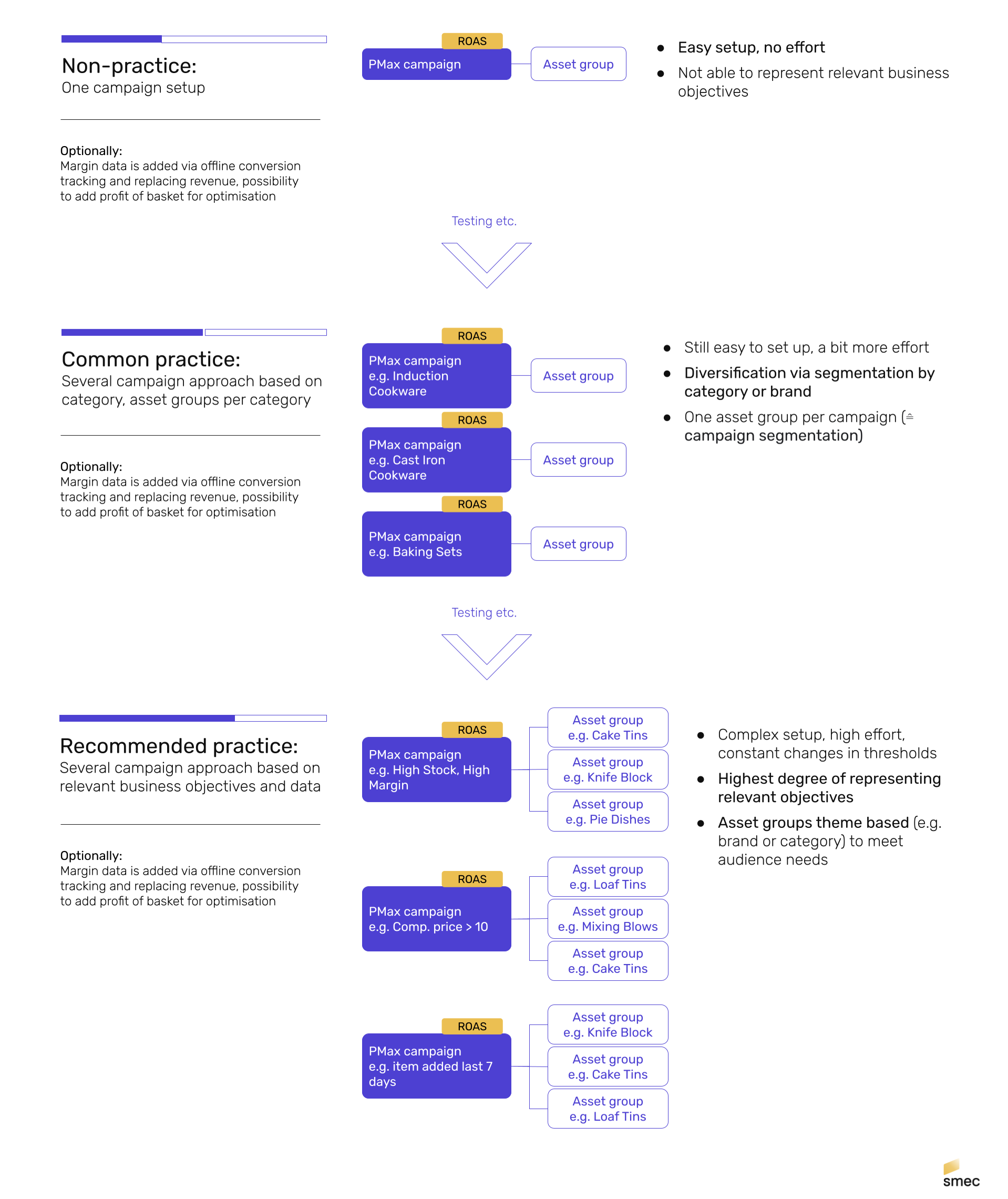
Check how we use clients’ data to manage the PMax algorithm
Read nowSo, what are the most important building blocks for optimising your Performance Max campaigns?
Performance Max optimisation for online retailers
Part 1: Segment your campaigns
Here’s how you can segment your campaigns, depending on what stage you are in:
Non-practice
The non-practice, as we defined it, is to have a single campaign with a single asset group. I’m sure there are businesses for which this makes sense – single-product companies or assortments with low heterogeneity. But many other product catalogues are richly faceted, and it would be a shame not to let a diamond sparkle.
Common practice
The common practice is to have a handful of campaigns, often splitting out products and budget by category. Maybe there is asset group segmentation, maybe not. For smaller businesses with less budget to spread around, or big-ticket assortments with low conversion volume, or folks who just want to follow the KISS principle, this could work.
Recommended practice
Our recommended practice is to find more strategic ways to segment your products:
How granular can you go?
In Standard Shopping campaigns, big performance gains have been possible with extremely granular structures and advanced segmentation like Martin Röttgerding’s famous query funneling approach. In Smart Shopping, and now PMax Retail, not only are such strategies impossible, but it is important not to be too segmented.
The goal is not to micromanage or “hack” the campaigns.
The goal is to recognize campaign structure as a vehicle for information. You want to create product clusters that address substantial chunks of conversion value with reasonable budget and meaningfully differentiated goals. This means a handful of campaigns, likely not more than 10. Each additional segment means additional maintenance and increased analytical effort, so each additional segment must be well justified.
Campaign structure should be based on relevant objectives. Each additional segment equals additional maintenance and analysis effort. We recommend only a handful of campaigns.
Part 2: Performance Max & Smart Shopping – Hybrid or pure play?
Some very smart people have proposed different hybrid approaches to Performance Max. This could mean some products are served via Performance Max, others via Standard Shopping. Or it could mean one campaign with no assets, another campaign with only assets. While we find these approaches interesting, we cannot currently recommend either. If you have seen brilliant outcomes with such approaches, please let me hear about it. But our current stance is there’s a certain risk in these setups and we haven’t found a crystal clear “reason why” for these – yet.
All or nothing
Don’t get me wrong, it’s perfectly reasonable to test Performance Max on only a portion of your products in order to get a solid decision basis whether or not to adopt further. But we view Performance Max as an either/or decision. Indeed, while Performance Max “plays nice” with other campaigns, generally deferring to ad rank, its dominance is structurally enforced in the case of Shopping. And regarding the assets hack, Google is promising to deliver highly effective full-funnel coverage. We’re willing to take them up on that promise – and hold them accountable. But personally I’d rather see someone either commit to Performance Max as it’s intended, or commit to Standard Shopping.
Hybrid approaches can have negative effects on your campaigns.
Part 3: Strategic inputs
Here’s where we can start to tie this all together a bit.
Google bids based on hundreds of signals which in turn are based on billions of transactions. Google does this for you – and for your competitors. So what kind of signals matter to your business? What data can you and only you offer about your inventory? Your customers? What factors drive success – or failure – outside of the campaign, across the broader business?
Guiding Google wisely
We recommend connecting Performance Max for online retail with conventionally off-feed, off-channel data to guide the platform in a manner that supports your business more than superficially.
Examples of this include, but are by no means limited to:
- stock level, or availability per size/color
- sell-through rate or inventory turn
- product lifecycle, launch all the way through overstock
- gross margin
- price attractiveness
- return rate
- lifetime value
Or combinations of these attributes. In a simple case, that could mean the intersection of margin and stock, or price attractiveness and competition density.
Connect Performance Max with off-feed, off-channel data to guide Google’s bidding and enable goal-oriented campaigns.
Advanced use of Performance Max
In a really advanced case, you could look at the interplay of multiple metrics. Warning; this can become overengineered. Just remember the guidance to look at addressable chunks of budget or revenue with meaningful strategic or performance differences. I’ll show you how to identify pockets of opportunity later on.
Again, ideally, you are covering information that Google is not aware of. This is not black and white, because firstly we don’t know all of Google’s signals. Secondly, and more importantly, Google doesn’t run your business. For example, doesn’t Google already consider price in the bid? Yes and no. They optimise on a per-auction basis, which is great because it’s real-time and therefore highly contextual. But conversely, it’s a narrow, operational view. Performance Max is not aware of your pricing strategy and will not strategically steer your campaign on that basis. That’s the human part.
Our proposal is not new in this regard – linking business and campaign data is something we’ve recommended for years – and yet the importance of this activity has never been higher, because automation has never been this extensive before, and ecommerce has never been this competitive before.
Plus, crucially, the mechanisms for achieving this need to be reevaluated for the new Performance Max technology.
You can bring this data to your campaigns via custom label – as always – but let’s look in more detail.
Use custom labels to link your business data with campaign data.
If you are now asking yourself: “How do I use this Performance Max approach for my campaigns?”, we recommend you check out our Performance Max guide. It’s a step-by-step guide on how to enhance your PMax campaigns with the help of data and automation.
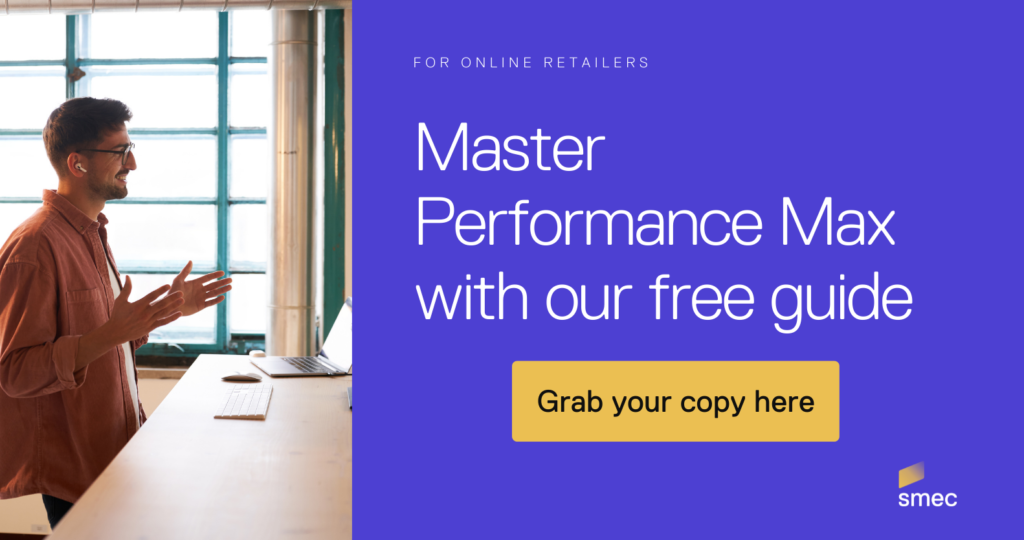
Next I will cover custom labels and how you can identify the right PMax strategy for your online retail business case using them.
Structure Performance Max campaigns with custom labels
Margin class is a very popular use of custom label that we’ve seen time and again in both Standard and Smart Shopping campaigns. While not as advanced as profit bidding, it’s a way of linking ROAS more tightly to true profitability. Let’s see how this strategy can play out in Performance Max.
The main challenge is that Performance Max is intended to be thematically driven. While text ad campaigns revolved around keywords, and Shopping campaigns around products, PMax has assets at its core. But products that are unified by an attribute like margin might not have anything in common thematically. So the question arises: can you structure Performance around a business objective like margin instead of a theme? Yes, you just have to consider both.
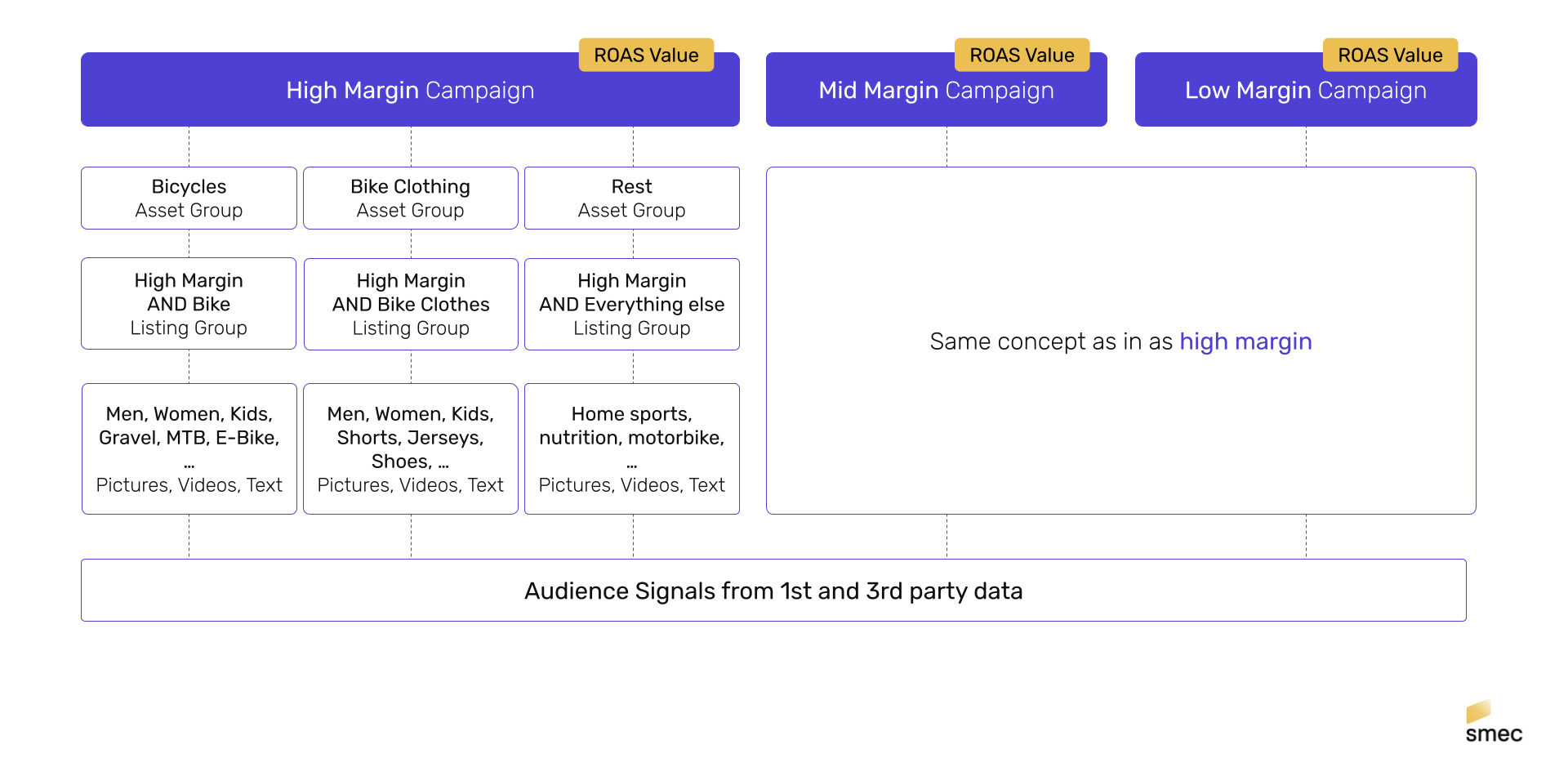
Here’s what you need to do:
1. Create a campaign per margin class, assign budget & ROAS target
First, you need to create a campaign per margin class, to which you will assign a budget and optionally a ROAS target. There’s perhaps a shift in mindset here. Rather than thinking of that ROAS target as a goal you need to reach, you must think of it as a lever to pull. Reaching the ROAS target is the algorithm’s job, not yours. Your job is to make sure the algorithm is delivering on the business objectives – in this case, margin.
Tweaking your ROAS target will quicken or slow the pace and amount of budget than can ultimately be consumed.
2. Create asset groups
Next you create asset groups to offer Performance Max the thematic guidance it needs to build and place creatives. How this looks will depend a lot on your catalog and what assets you have available. You should start with a generic asset group and build out from there – and you should always keep that asset group to serve as a catch-all.
There’s the risk that your assets and the derived creatives could be too generic, so consider breaking out by product type, brand, collection, season, etc. This is the kind of segmentation that we often see on the campaign level currently. We recommend bringing that down to the asset group level.
At the listing group level, you can apply your custom label to bring in the external data. This is a simple AND logic between your desired custom label value and your desired theme. The output will be a product set and assets needed to serve.
3. Add data
The last layer is the first-party customer data you can bring in and the third-party audience data from Google.
Some additional notes for your PMax strategy:
- Ideally one product is managed by one campaign, not multiple campaigns
- Listing groups should be different per asset group
- Audience signals can be the same per asset group, or you could consider varying in the case of strongly divergent personas
- Note: audience signals are soft targeting – just a starting point upon which Google will expand
- We recommend segmenting by product type such as pants with no gender or age segmentation (womens, mens, kids). Google’s algorithm is supposed to handle this
The big job for you to do is the selection of strategic attributes. This will depend on what data you have available or can make available – but also as mentioned it’s about finding the right level of segmentation that addresses pockets of opportunity. Let’s explore that.
See how we at smec run Performance Max campaigns
Read nowFinding the right Performance Max strategy in ecommerce
My recommendation is for you to get custom labels in your feed which reflect the data you’re interested in, starting with a simple Performance Max structure like the non- or common practice above. And then wait.
Start simple & constantly improve
You need to capture a baseline observation. This allows you to answer questions like: How are revenue and cost distributed across my custom labels? What does the raw, as-is performance look like in these buckets?
This is important first to identify pockets of opportunity, and later to see if you are moving the needle with your structure.
Identify the right custom label combinations
I like to use quadrant analysis to brainstorm fruitful custom label combinations. You can arrive at setups that are reasonably complex but not overengineered. Also, for custom labels with numeric values, it’s simple to convert that framework into an actual scatterplot to check reality against theory. Even better, if you use a bubble chart, you can get a deeper analysis by assigning the bubble size to cost, revenue, or performance metrics. For custom labels with categorical/qualitative data, you need to get a touch more creative, but it’s also feasible.
This can be a powerful method for investigating the interplay of your campaign data and business data. You can check if the cost or revenue is addressable (large enough to be worth your time), and if there’s anything to be done there. What is the ROAS of a given pocket – is there room to tweak it up or down in order to change volume? What is driving the difference currently – is it conversion rate, AOV, or both? And what about CPC, how are the unit costs here?
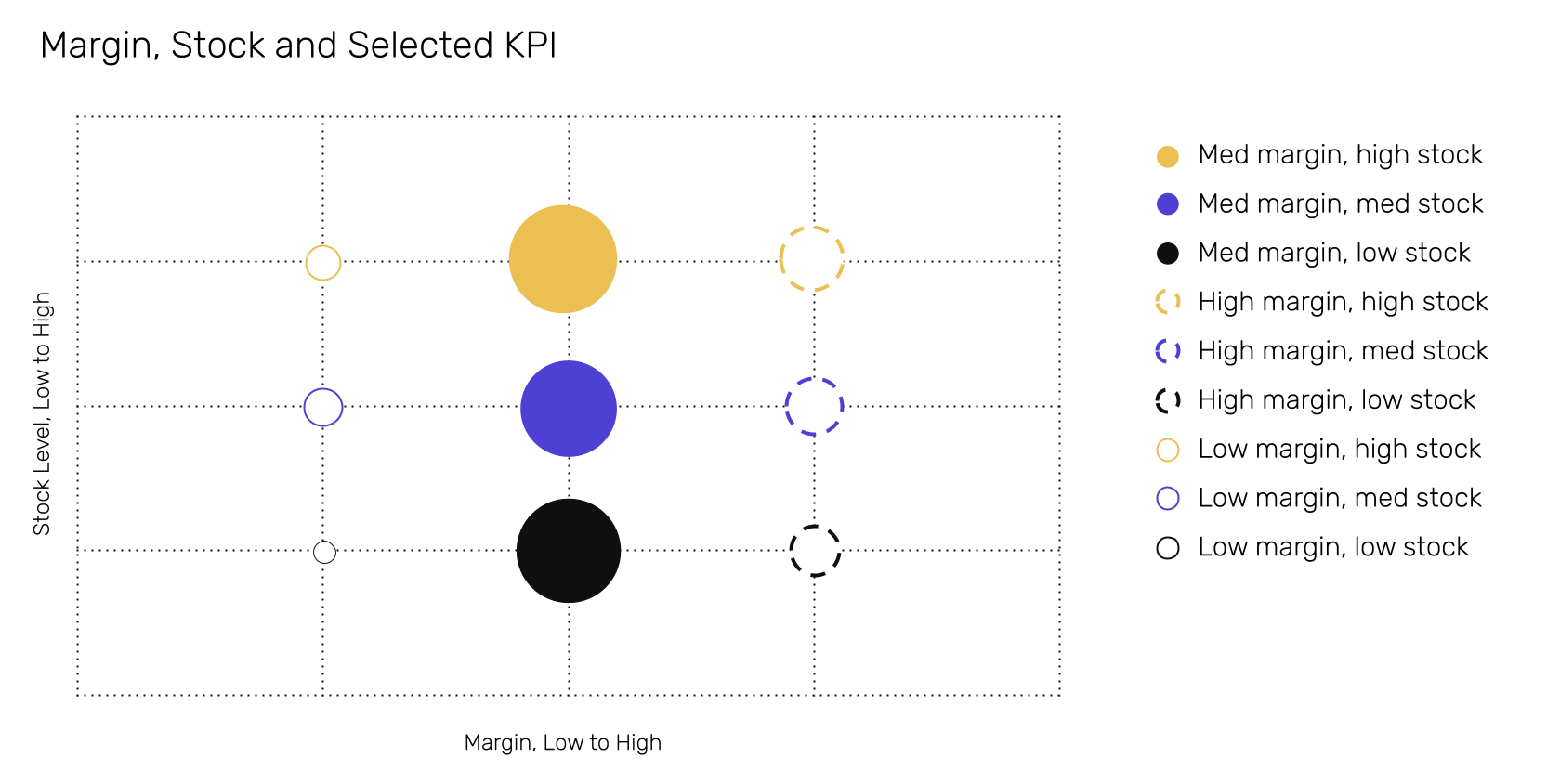
In this example, the y-axis represents stock level from low to high, while the x-axis represents margin, low to high. The bubble size reflects any given metric, in this case conversion value (revenue).
Explore your custom label data
This is one way to explore categorical custom label data, and even for quantitative data you might purposely bucket the data like this. The specific premise here is that high stock, high margin items should be budgeted and paced most aggressively, while low stock, low margin items should be paced most conservatively. For this account, we know that while there is an even distribution of medium- and high-margin products, the high-margin products are generating less revenue. Meanwhile, the low-margin items are in some cases throttled too much and stock level is not visibly reflected. This is a baseline worth discussing.
Final thoughts
I hope this article will at the very least spur thought and debate – and hopefully action. In my opinion the key challenges for your Performance Max strategy and campaigns are related to mindset:
- Shifting from ROAS as a goal, to ROAS as a lever
- Thinking not only in terms of total growth, but targeted growth
- Trusting an automation technology into which we cannot see
- Accepting the de-channeling of search, shopping, display
Shopping For Business Objectives
Before wrapping up, I’d like to quickly mention a relatively obscure Google program known as Shopping For Business Objectives. The approach is in many ways similar to what I’ve described here, and I’ve admired it for years. I saw a Performance Max Retail webinar recently, which had some old slides dating back to at least 2019, polished and adapted for the new Performance Max world.
Why do I mention this? I was very glad to see it, because it validates that Google supports approaches like ours. While some “best practices” from Google feel self-serving, SFBO has always been about what’s best for the advertiser, not only in terms of campaign results, but in terms of business results. Plus, one of my goals (currently, at least) is not to “hack”, break, or contradict Google’s Performance Max guidelines in any way. The technology is too new and loopholes can be closed fast.
Clicked vs. bought discrepancies
One last thought to conclude: There is still a big unresolved problem space in front of us. As I mentioned earlier, it’s essential to optimise inputs and outputs. Those inputs are largely product-based, while the outputs are order-based. This discrepancy between what is clicked and what is bought gets even more complex in the case of PMax, which also sends traffic to brand and category landing pages. This challenge is not only present for advertisers, but for Google as well. We have thoughts about how to tackle this in Performance Max, but it requires testing. Stay tuned!
You want to dive even deeper into the topic of PMax campaigns and want to use the campaign type to your advantage? Then make sure to check out the recording of our most recent Performance Max webinar.
